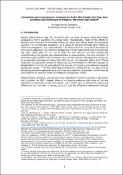Options
Comparing pay transparency measures to tackle the Gender Pay Gap: best practices and challenges in Belgium, Denmark and Iceland
Author(s)
Date Issued
2021-11-01
Date Available
2023-06-27T10:29:40Z
Abstract
Gender differences in pay for the same work or work of equal value have been outlawed in many countries for a long time. Traditionally, most of the efforts to address them focused on remedial action via equal pay claims taken by individual workers, or in best-case scenarios, by a group of workers through joint claims or collective complaints (e.g. class actions). In some contexts, they have also been at least partly addressed via collective bargaining. In the light of the persisting Gender Pay Gap (GPG) (still at 14.1 % in 2019 for the EU-27) and the widespread understanding that gender pay discrimination is unacceptable, yet very common, a relatively large number of jurisdictions have introduced pay transparency measures as a regulatory strategy to reduce the GPG as part of a broader policy mix. These measures are generally aimed at disclosing pay information to different groups of stakeholders in order to understand the sources of inequity and advance towards gender pay equity. Yet they also raise concerns on various fronts, i.e. they involve disclosing sensitive personal data and may add costs for employers, which may be more difficult to bear for Small and Medium Enterprises (SMEs). Despite these concerns, pay transparency regulation is worth including in the policy mix to tackle the GPG. Indeed, there is increasing evidence that some of the key obstacles to achieving gender pay equity, such as the lack of awareness about pay differences and barriers to access justice, can be effectively addressed through better pay transparency. [...] While pay transparency is not a new tool to address the GPG, it has recently become much more popular, in Europe and elsewhere. Part of this impetus can be explained by the EU’s interest in a wide range of policy measures that can contribute to address gender inequalities, including the Commission Recommendation on strengthening the principle of equal pay between men and women through transparency (2014/124/EU, hereinafter, ‘the Recommendation’). Following the adoption of the European Pillar of Social Rights, a series of complementary soft and hard-law EU measures could also become instrumental to tackle the GPG, like the Directive on Work-Life Balance, and most notably, the Proposal for a Directive to strengthen the application of the principle of equal pay for equal work or work of equal value between men and women through pay transparency and enforcement mechanisms (hereinafter, ‘the Directive Proposal’). [...] This article analyses the legislation and experiences of three jurisdictions which already have pay transparency measures in place (Belgium, Denmark and Iceland), with reference to key features of the Recommendation and the Directive Proposal, where relevant.
Sponsorship
University College Dublin
Type of Material
Journal Article
Publisher
European Commission
Journal
European Equality Law Review
Issue
2/2021
Start Page
1
End Page
20
Language
English
Status of Item
Peer reviewed
ISSN
2443-9606
This item is made available under a Creative Commons License
File(s)
Loading...
Name
SBL_ELR_article_pay transparency_ACCEPTED_TO SHARE.pdf
Size
419.34 KB
Format
Adobe PDF
Checksum (MD5)
b970931d0196e6f0a75c1d7d97f6e352
Owning collection